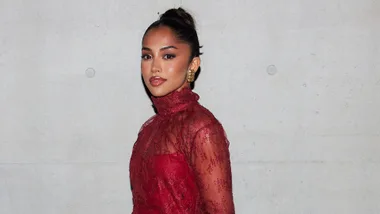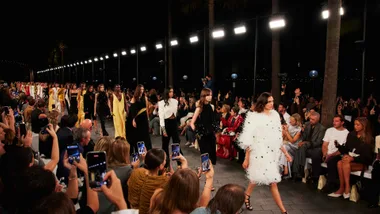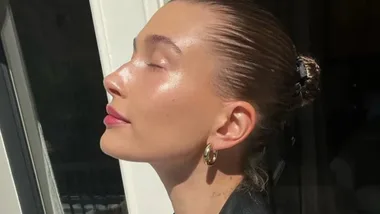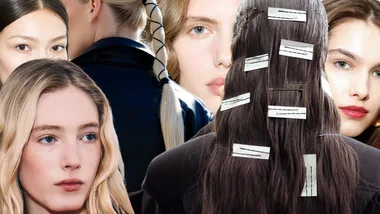Hair extensions tend to get a bad rap. And when you consider their telltale signs i.e. clips peaking out at the scalp, scraggly and damaged ends or completely mismatched colours, you can understand why there’s a general consensus that they can make your overall look appear fake and cheap.
But hair extensions have a come a long way. There are now better-quality and very natural-looking options on the market and improved application methods. It’s time you gave them a second chance. Extensions can be one of your hair’s biggest assets, allowing you to rock a variety of different hairstyles without having to commit to a certain look for too long.
To find out everything you need to know before investing in a set of faux strands, from the different varieties, how to look after them and how much you can expect to pay, we spoke to two hair experts: hairstylist, owner of Valonz salon and Cloud Nine Ambassador, Renya Xydis, and Hair Director and co-founder of MOB HAIR, Tarryn Cherniayeff.
1. The different types of hair extensions
According to Xydis, there are various types of hair extensions, however, the most popular include “clip-in, sew-in, micro-link, glue-in and tape extensions.”
“Clip-in hair extensions are the easiest to apply and the least damaging, as they simply clip in to your natural hair. Sew-in extensions are applied by braiding natural hair into a cornrow before sewing the hair extensions into the cornrow,” explains Xydis. She adds that sew-in extensions are one of the most seamless and permanent extension styles.
“Glue-in (extensions glued to natural hair) and micro-link (looping the extensions through the natural hair, clamping them with a hot tool and metal rings) are the most damaging on hair. However, they can both be reused if cared for,” Xydis explains.
Lastly, Cherniayeff says tape extensions “are attached to the hair using discreet double-sided tape, like a sandwich: Imagine one extension is the bottom piece of the bread, your hair is the filling and the top extension is the top piece of bread.”
2. How to know what hair extensions to use
Xydis and Cherniayeff both stress that it’s essential that you chat to your hairdresser before committing to any type of extensions. Cherniayeff says doing so will enable you to factor in your lifestyle, budget and your natural hair to see what is going to work best for you, as choosing the wrong ones can have negative effects. “For instance, if you’re a low-maintenance person and you’re not willing to set aside time to take care of your extensions, you may find yourself with matted roots and unmanageable hair.”
An in-depth discussion with your hairdresser will also enable you to choose the right colour, address any concerns you may have and learn which products are best for styling and caring for hair extensions
3. Can you have hair extensions with balayage?
f you’ve always avoided hair extensions because you thought you’d never be able to get them to match your ombré or balayage hair colour, we have good news for you.
Both Cherniayeff and Xydis agree that those with multiple colours and tones throughout their hair will be able to find extensions that match and look natural. By combining a “mixture of dark and light extensions, you’re actually able to create a balayage effect on its own,” says Cherniayeff.
However, if you’ve recently jumped aboard the ombré or balayage trend or have changed your hair colour completely and want to get your existing extensions to match your new shade, then you might run into a bit of trouble. “Some salons will colour them for you, however, you should expect the results to vary. This is because some extensions have been put through certain processes to get to the colour they are currently at, which means they may not ‘take’ to the colour you are trying to add to it. In which case, sometimes considering new extensions may be your best option,” advises Cherniayeff.
4. Choosing between synthetic or human hair extensions
While synthetic hair extensions (made from various blended synthetic fibres) might seem more appealing because they are significantly cheaper, extensions made from human hair are generally the best way to go.
“Synthetic extensions can be stiff and don’t often blend into hair as easily. Alternatively, human hair blends effortlessly into natural hair and can be dyed (when possible) to match natural hair,” says Xydis.
5. How to look after hair extensions
“Every brand of extensions has their own after-care routine, which you should be fully aware of prior to purchase. But in general, opt for sulphate-free shampoos, avoid applying conditioner to your roots and treat the hair as if it’s your own i.e. weekly treatments etc.,” says Cherniayeff.
Three sulphate-free shampoos to try are L’Oréal Paris Botanicals Fresh Care Lavender Shampoo, Redken Frizz Dismiss Sulfate-Free Shampoo and Kérastase Paris Bain Fluidealiste.
Xydis recommends not brushing your hair when it’s wet as it may excessively tug your extensions. She also suggests avoiding “oil-based hair products and over-styling with hot tools for micro-link and glue-in extensions. Clip-in hair extensions are very low maintenance; however, they should be washed after every 20 uses or so, but more frequently if you use a lot of product on your hair. They can then be brushed, shampooed and conditioned as normal and then air-dried.”
6. How often you should replace hair extensions
“Synthetic extensions last for a few months on average, whereas human hair extensions can last upwards of one year if they are well taken care of,” says Xydis. As for how often you will need to get your hair extensions re-applied, she advises, “Glue and tape extensions last around four to eight weeks, sew-in extensions should be replaced every six to eight weeks and micro-link extensions last up to four months, but will need repositioning every two or three months as your hair grows.”
7. Who should avoid hair extensions?
Unfortunately, they’re aren’t for everybody. “If your hair is overly damaged, thin or brittle, it’s best to stay away from extensions that require glue or heat application,” says Xydis. “Those with fine hair should also avoid micro-links as the bonds may be visible,” she adds. Cherniayeff’s tip is to steer clear of extensions (excluding clip-ins) if you’re prone to scalp conditions.
8. How much you can expect to pay
Prices for hair extensions will vary greatly depending on location, the quality of the hair used and the amount of hair needed. However, on average you can expect to pay anywhere between $50 – $400 for clip-ins, $100 – $1000 for glue-in and sew-in extensions, $300 to $1000+ for tape hair extensions and $1000 – $4000 for semi-permanent extensions like micro-link ones.
This article originally appeared on Beauty Crew.
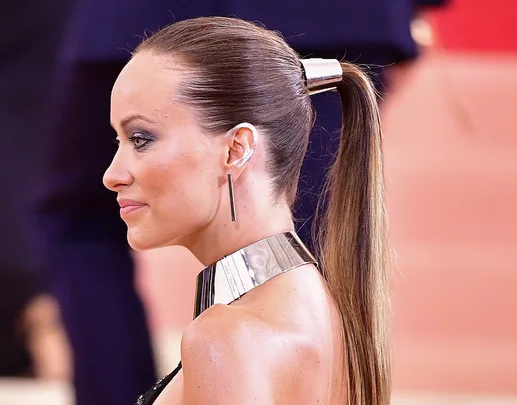 Getty
Getty
